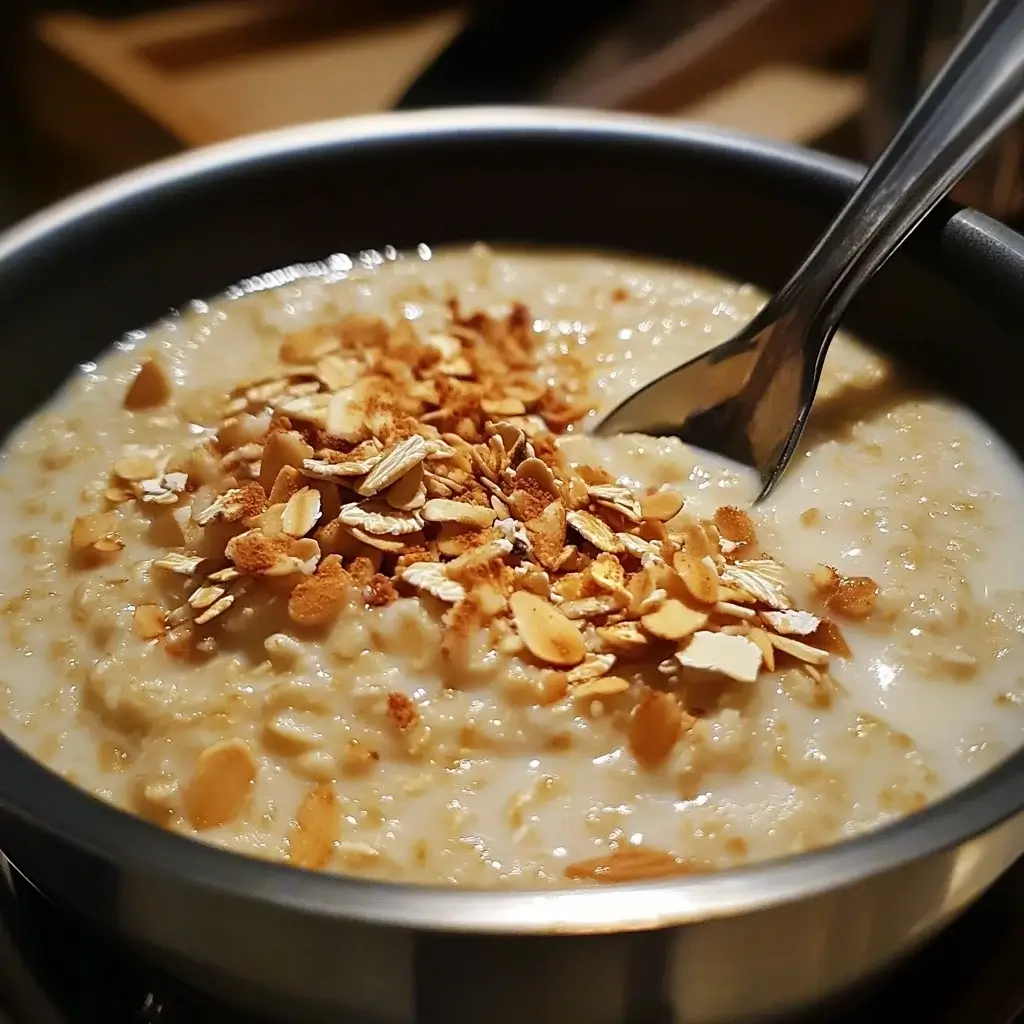Norwegian porridge, known as “grøt” in Norway, is a beloved breakfast staple that offers warmth, comfort, and nourishment. This hearty dish is not just a meal but an experience that connects you with centuries of Nordic tradition. Whether you’re looking for a healthy start to your day or a cozy evening treat, this warm Norwegian porridge provides the perfect blend of taste and nutrition. In this article, we’ll guide you through the process of making this delightful dish, exploring its ingredients, nutritional benefits, and serving suggestions.
Ingredients
To embark on this culinary journey, you will need the following ingredients:
- 1 cup rolled oats
- 4 cups water or milk (any plant-based milk works)
- 1/4 teaspoon salt
- 1 tablespoon honey or maple syrup
- Toppings: Fresh fruits, nuts, or cinnamon
Instructions
Creating this comforting dish is simple and requires minimal effort. Follow these steps to make your warm Norwegian porridge:
- Boil the Base: In a saucepan, bring water or milk and salt to a boil.
- Add the Oats: Stir in rolled oats and reduce the heat. Allow it to cook for 5-7 minutes, stirring occasionally, until it reaches a creamy consistency.
- Sweeten the Porridge: Remove from heat and mix in honey or maple syrup to add a touch of sweetness.
- Serve and Enjoy: Serve the porridge warm, adding your favorite toppings for an extra burst of flavor and texture.
Nutrition Facts
Understanding the nutritional content of your meals is essential for a balanced diet. Here’s the breakdown of the nutrition facts per serving of warm Norwegian porridge:
- Calories: 150
- Protein: 5g
- Carbohydrates: 28g
- Fat: 3g
- Fiber: 4g
This porridge offers a balanced mix of macronutrients and is a fantastic source of fiber, making it an ideal choice for those seeking a healthy breakfast.
How to Serve
Porridge is not only a comforting and nutritious breakfast option, but it is also a highly versatile dish that can be tailored to suit individual tastes and dietary preferences. By incorporating a variety of toppings and mix-ins, you can transform your bowl of porridge into a delightful and satisfying meal. Here are some detailed serving suggestions to enhance your porridge experience:
1. Fruits
Fresh Fruits: Adding fresh fruits is one of the simplest and most effective ways to elevate your porridge. Consider using:
- Berries: Blueberries, strawberries, raspberries, or blackberries add a burst of natural sweetness and vibrant color. They are also rich in antioxidants, vitamins, and fiber.
- Bananas: Sliced bananas provide a creamy texture and natural sweetness. They are also a great source of potassium, which is essential for heart health and muscle function.
- Apples: Chopped apples, especially when cooked slightly or mixed with a sprinkle of cinnamon, can create a warm and comforting flavor. Apples are high in fiber and vitamin C.
- Stone Fruits: Peaches, plums, or cherries can be delicious additions, especially in summer. Their juicy sweetness pairs well with the warm, creamy base of porridge.
Dried Fruits: Don’t overlook dried fruits like raisins, cranberries, or apricots. They add chewiness and a concentrated sweetness. Soaking them briefly in warm water or mixing them in while cooking can help soften their texture.
2. Nuts
Nut Toppings: Adding nuts provides a satisfying crunch along with healthy fats and protein. Consider:
- Almonds: Sliced or chopped almonds can add a delightful crunch, along with vitamin E and magnesium.
- Walnuts: These nuts are high in omega-3 fatty acids, which are beneficial for brain health. Their slightly bitter flavor pairs well with sweet toppings.
- Pecans: With their rich, buttery flavor, pecans can enhance the overall taste profile of your porridge. They also provide a good source of fiber and healthy fats.
Nut Butters: For an extra layer of creaminess and flavor, consider swirling in a spoonful of almond butter, peanut butter, or cashew butter. These not only add richness but also increase the protein content, making your porridge more filling.
3. Spices
Flavor Enhancements: A dash of spices can completely transform your porridge into a fragrant delight. Popular choices include:
- Cinnamon: Known for its warm and sweet flavor, cinnamon can help regulate blood sugar levels and add a cozy feel to your dish. You can sprinkle it on top or mix it in while cooking.
- Nutmeg: This spice adds a slightly nutty and sweet flavor. Use it sparingly, as its strong aroma can be overpowering.
- Ginger: Freshly grated or powdered ginger can introduce a zesty kick and is known for its digestive benefits. It pairs particularly well with apple or pear toppings.
- Cardamom: This aromatic spice adds a unique, floral flavor. It’s commonly used in Middle Eastern and Indian cuisine, making it an interesting twist for your porridge.
4. Yogurt
Creamy Toppings: A dollop of yogurt can add creaminess and a tangy flavor, enhancing the overall texture of your porridge. Consider:
- Greek Yogurt: High in protein and creamier than regular yogurt, Greek yogurt can provide a satisfying richness and a probiotic boost.
- Plant-Based Yogurt: For a dairy-free option, try coconut, almond, or soy yogurt. These can add unique flavors and textures while still contributing creaminess.
Layering: For a more visually appealing presentation, try layering your yogurt with the porridge and toppings in a glass. This not only looks beautiful but also allows for different flavor combinations in each bite.
5. Seeds
Nutritional Boost: Seeds are packed with nutrients and can enhance the health benefits of your porridge. Some great options include:
- Chia Seeds: These tiny seeds are high in omega-3 fatty acids, fiber, and protein. When soaked, they develop a gel-like consistency, which can add a unique texture to your porridge.
- Flaxseeds: Ground flaxseeds are an excellent source of lignans and omega-3s. They can easily be mixed into your porridge for added health benefits.
- Pumpkin Seeds: Also known as pepitas, these seeds provide a nutty flavor and are rich in magnesium, zinc, and antioxidants. Toasting them slightly can enhance their flavor and crunch.
- Sunflower Seeds: These seeds add a mild, nutty taste and are a good source of vitamin E and healthy fats.
Conclusion
With these varied and delicious serving suggestions, your porridge can be transformed from a simple bowl of oats into a gourmet breakfast experience. Feel free to experiment with different combinations and proportions to find your perfect mix. The beauty of porridge lies in its adaptability—whether you prefer sweet, savory, fruity, or nutty flavors, there’s no limit to how you can enjoy this wholesome dish. So grab your favorite ingredients and start creating your ideal porridge bowl today!
Additional Tips
To truly elevate your experience with Norwegian porridge, or “grøt,” consider the following comprehensive tips that delve deeper into preparation, flavor variations, and storage. These suggestions aim to maximize both the texture and taste of your porridge while accommodating individual preferences and seasonal ingredients.
Consistency Adjustments
The texture of your Norwegian porridge can significantly influence your overall enjoyment. To tailor the consistency to your liking, here are some detailed methods to adjust the thickness:
- Thicker Porridge: If you enjoy a denser, creamier porridge, begin by reducing the liquid ratio. For example, if the standard recipe calls for 2 cups of water or milk for every cup of oats, try decreasing the liquid to 1.75 cups. This reduction creates a heartier base that holds toppings better and provides a more satisfying mouthfeel.
- Softer Porridge: For those who prefer a lighter and more fluid texture, simply increase the liquid. Adding an extra ¼ cup of water or milk can transform your porridge into a silky, smooth dish that’s easy to enjoy. Experiment with the ratios until you find your perfect balance, keeping in mind that factors like the type of oats used (rolled vs. steel-cut) may also affect the final texture.
Overnight Option
One of the most convenient and beneficial methods for preparing Norwegian porridge is the overnight soaking technique. Here’s how to effectively use this option:
- Soaking Process: The night before, combine your oats with the liquid of your choice—milk, almond milk, or even water—in a bowl. Use a ratio of 1 cup of oats to 2 cups of liquid. Cover the bowl and refrigerate overnight. This soaking process not only softens the oats but also enhances their nutritional profile, making them easier to digest.
- Reduced Cooking Time: In the morning, simply heat the soaked mixture on the stove or in the microwave, which typically takes just a few minutes. This method is particularly beneficial for busy mornings, allowing you to enjoy a wholesome breakfast with minimal effort.
Sweetener Choices
While traditional Norwegian porridge is often served plain or with a sprinkle of sugar, there are myriad sweeteners you can use to customize your dish:
- Natural Sweeteners: Consider using honey, maple syrup, agave nectar, or coconut sugar for a natural alternative. Each sweetener brings its own unique flavor profile; for instance, maple syrup adds a rich, caramelized note, while agave nectar is milder and less intrusive.
- Sugar Alternatives: If you’re watching your sugar intake, try using stevia or monk fruit sweetener, both of which provide sweetness without added calories. You can also experiment with flavored extracts, like vanilla or almond, to add depth to your porridge without relying solely on sweeteners.
Seasonal Variations
Taking advantage of seasonal ingredients not only enhances the flavor of your Norwegian porridge but also makes it more enjoyable throughout the year:
- Autumn Inspirations: In the fall, consider adding pumpkin puree and a sprinkle of pumpkin spice (nutmeg, cinnamon, ginger) to evoke the cozy flavors of the season. Toppings like roasted pecans or walnuts can provide a satisfying crunch.
- Winter Comforts: During the colder months, try mixing in apple slices sautéed in cinnamon and brown sugar or a dollop of Nutella for a comforting treat that warms you from the inside out.
- Spring and Summer Freshness: As the weather warms, top your porridge with fresh fruits like strawberries, blueberries, or peaches. A drizzle of honey and a sprinkle of chia seeds can add a nutritious twist. You might also consider incorporating fresh herbs like mint for a refreshing finish.
Storage
If you prepare more porridge than you can consume in one sitting, proper storage is essential to maintain its quality:
- Refrigeration: Store any leftovers in an airtight container in the refrigerator for up to three days. This ensures that your porridge remains fresh and prevents it from absorbing other odors from the fridge.
- Reheating Tips: When it’s time to enjoy your leftover porridge, add a splash of milk or water before reheating. This helps to restore the creamy texture, as porridge can thicken as it cools. Warm it on the stove over low heat or in the microwave until heated through, stirring occasionally to ensure even warming.
By incorporating these detailed tips into your Norwegian porridge-making routine, you’ll not only enhance your culinary experience but also enjoy a versatile dish that can be adapted to your personal tastes and seasonal ingredients. Whether you’re preparing a quick breakfast or a leisurely weekend treat, these insights will help you savor every spoonful of this delightful comfort food.
FAQs
What is the origin of Norwegian porridge?
Norwegian porridge, or “grøt,” is a traditional Scandinavian dish that has been a part of Norwegian culture for centuries. It is often associated with gatherings and celebrations and is enjoyed as a comforting meal throughout the year.
Can I make this porridge gluten-free?
Yes, simply ensure that you use certified gluten-free rolled oats to make this porridge suitable for a gluten-free diet.
What plant-based milk works best for this recipe?
Almond milk, oat milk, and coconut milk are popular choices that complement the flavors of porridge well. Each type of milk brings a unique taste and texture, so feel free to experiment.
Is this porridge suitable for vegans?
Absolutely! By using plant-based milk and maple syrup as the sweetener, this porridge is entirely vegan-friendly.
Can I prepare this porridge in advance?
Yes, you can prepare the porridge in advance and store it in the refrigerator. Reheat it on the stove or microwave, adding a little extra liquid to restore its creamy texture.
Conclusion
Warm Norwegian porridge is more than just a meal; it’s a comforting embrace on a chilly morning or a cozy evening. Rooted in tradition and enriched with modern twists, this dish offers a wholesome and delicious start to your day. With its simple preparation, customizable toppings, and excellent nutritional profile, Norwegian porridge is a must-try for anyone seeking a taste of Nordic culinary heritage. Whether you enjoy it with fresh fruits, crunchy nuts, or aromatic spices, this porridge is sure to become a beloved staple in your kitchen. So, gather your ingredients and experience the warmth of Norwegian porridge today!
Print
Egg and Cheese Breakfast Sandwich
Ingredients
Before diving into the preparation process, let’s gather all the ingredients. Here’s what you’ll need for a delightful Egg and Cheese Breakfast Sandwich:
- 1 English muffin (or bagel)
- 1 large egg
- 1 slice of cheese (cheddar or your choice)
- 1 slice tomato (optional)
- Salt and pepper to taste
- Butter or cooking oil for frying
Instructions
Preparing an Egg and Cheese Breakfast Sandwich is a straightforward process that even beginners can master. Follow these easy steps to whip up a delightful breakfast treat:
- Toast the Muffin:
- Split the English muffin and toast it until it’s golden brown. This ensures a crispy texture that complements the soft egg and melted cheese.
- Cook the Egg:
- In a small skillet, heat butter or oil over medium heat.
- Crack the egg into the skillet and cook until the white is set. Season with salt and pepper to taste.
- Add Cheese:
- Place the slice of cheese on top of the egg while it’s still in the skillet. Allow it to melt slightly, blending beautifully with the egg.
- Assemble:
- Layer the cooked egg and melted cheese on the toasted muffin. If you’re adding a tomato slice, place it on top of the cheese. Top with the other half of the muffin.
- Serve:
- Enjoy your warm and cheesy breakfast sandwich! It’s best served immediately to appreciate the gooey cheese and perfectly cooked egg.
Nutrition
- Serving Size: one normal portion
- Calories: 350
- Fat: 18g
- Carbohydrates: 30g
- Fiber: 2g
- Protein: 18g





